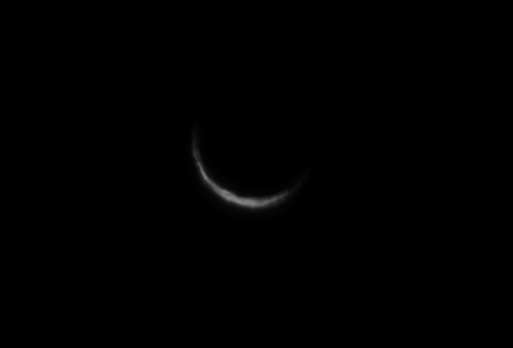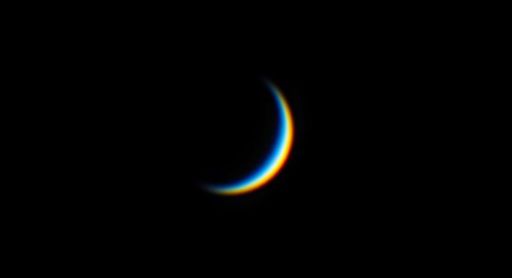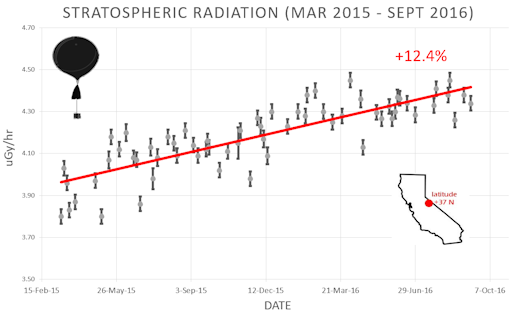Directly under the Arctic Circle! Marianne's Arctic Xpress in Tromsø offers fjord, whale and wildlife tours by day, aurora tours by night. Email Marianne for bookings and availability. | | | GEOMAGNETIC STORM: A G1-class geomagnetic storm is underway on March 21st as a high-speed stream of solar wind buffets Earth's magnetic field. The stream is broad and Earth could remain inside it for the next three days. Arctic sky watchers should be alert for auroras shining through the waxing twilight of northern Spring. Free: Aurora Alerts First contact with the solar wind stream on March 20th sparked a colorful display of auroras outside Fairbanks, Alaska: 
"The colors were so beautiful, and it was amazing to watch the curtains wave and change from moment to moment," reports photographer John Chumack. "Our crew enjoyed this dynamic display for many hours." Realtime Aurora Photo Gallery WHERE NO REINDEER HAS GONE BEFORE: The students of Earth to Sky Calculus have just returned from a week-long space weather ballooning campaign inside the Arctic Circle. To help pay for the trip, they launched a payload full of reindeer pendents to the edge of space--and you can have one for $129.95. 
The pendants traveled to the Arctic stratosphere alongside an array of cosmic ray sensors. Launching from the frozen surface of Lake Torneträsk near Abisko, Sweden, the payload soared into a crystal-clear blue sky illuminated by the recently-risen springtime sun. Each glittering pendant comes with a greeting card showing the jewelry in flight and telling the story of its journey 97,000 feet above the Lapland of Northern Sweden. More far-out gifts may be found in the Earth to Sky store. Realtime Space Weather Photo Gallery TWINKLE, TWINKLE, CRESCENT VENUS: Like the Moon, Venus has phases, and right now it is a beautifully slender crescent. On March 17th, Italian astronomer Raffaello Lena used a small telescope to track Venus down to the horizon as it set in the evening sky of Rome. He recorded a beautiful example of atmospheric turbulence distorting the curved lines of the second planet:

This kind of scintillation is normally reserved for pinpoint objects like distant stars. Venus is so thin, it's doing it too. In a related development, some observers have recorded the chromatic splitting of Venus into red, green, and blue crescents, making Venus look like a tiny rainbow in space. All of this is happening because Venus is passing between Earth and the sun--an event astronomers call "inferior solar conjunction." As Venus turns its night side to Earth, only a luminous sliver remains. Observers can find Venus shining through the twilight in the western sky at sunset. The crescent is easy to see in small telescopes and binoculars. 
Above: "Rainbow Venus" photographed by Kevin R. Witman of Cochranville PA [more]
The Venus-sun distance will be least on March 25th. This is the most beautiful time to observe Venus, but also the most perilous. The glare of the nearby sun magnified by a telescope can damage the eyes of anyone looking through the eyepiece. Anthony J. Cook of the Griffith Observatory has some advice for observers: "I have observed Venus at conjunction, but only from within the shadow of a building, or by adding a mask to the front end of the telescope to fully shadow the optics from direct sunlight. This is tricky with a refractor or a catadioptric, because the optics start at the front end of the tube. Here at Griffith Observatory, I rotate the telescope dome to make sure the lens of the telescope is shaded from direct sunlight, even through it means that the lens will be partially blocked when aimed at Venus. With our Newtonian telescope, I add a curved cardboard mask at the front end of the tube to shadow the primary mirror." Realtime Venus Photo Gallery
Realtime Comet Photo Gallery
Every night, a network of NASA all-sky cameras scans the skies above the United States for meteoritic fireballs. Automated software maintained by NASA's Meteoroid Environment Office calculates their orbits, velocity, penetration depth in Earth's atmosphere and many other characteristics. Daily results are presented here on Spaceweather.com. On Mar. 21, 2017, the network reported 27 fireballs.
(27 sporadics)  In this diagram of the inner solar system, all of the fireball orbits intersect at a single point--Earth. The orbits are color-coded by velocity, from slow (red) to fast (blue). [Larger image] [movies] Potentially Hazardous Asteroids ( PHAs) are space rocks larger than approximately 100m that can come closer to Earth than 0.05 AU. None of the known PHAs is on a collision course with our planet, although astronomers are finding new ones all the time. On March 21, 2017 there were 1780 potentially hazardous asteroids. Notes: LD means "Lunar Distance." 1 LD = 384,401 km, the distance between Earth and the Moon. 1 LD also equals 0.00256 AU. MAG is the visual magnitude of the asteroid on the date of closest approach. | | Cosmic Rays in the Atmosphere |
Readers, thank you for your patience while we continue to develop this new section of Spaceweather.com. We've been working to streamline our data reduction, allowing us to post results from balloon flights much more rapidly, and we have developed a new data product, shown here: 
This plot displays radiation measurements not only in the stratosphere, but also at aviation altitudes. Dose rates are expessed as multiples of sea level. For instance, we see that boarding a plane that flies at 25,000 feet exposes passengers to dose rates ~10x higher than sea level. At 40,000 feet, the multiplier is closer to 50x. These measurements are made by our usual cosmic ray payload as it passes through aviation altitudes en route to the stratosphere over California. What is this all about? Approximately once a week, Spaceweather.com and the students of Earth to Sky Calculus fly space weather balloons to the stratosphere over California. These balloons are equipped with radiation sensors that detect cosmic rays, a surprisingly "down to Earth" form of space weather. Cosmic rays can seed clouds, trigger lightning, and penetrate commercial airplanes. Furthermore, there are studies ( #1, #2, #3, #4) linking cosmic rays with cardiac arrhythmias and sudden cardiac death in the general population. Our latest measurements show that cosmic rays are intensifying, with an increase of more than 12% since 2015: 
Why are cosmic rays intensifying? The main reason is the sun. Solar storm clouds such as coronal mass ejections (CMEs) sweep aside cosmic rays when they pass by Earth. During Solar Maximum, CMEs are abundant and cosmic rays are held at bay. Now, however, the solar cycle is swinging toward Solar Minimum, allowing cosmic rays to return. Another reason could be the weakening of Earth's magnetic field, which helps protect us from deep-space radiation. The radiation sensors onboard our helium balloons detect X-rays and gamma-rays in the energy range 10 keV to 20 MeV. These energies span the range of medical X-ray machines and airport security scanners. The data points in the graph above correspond to the peak of the Reneger-Pfotzer maximum, which lies about 67,000 feet above central California. When cosmic rays crash into Earth's atmosphere, they produce a spray of secondary particles that is most intense at the entrance to the stratosphere. Physicists Eric Reneger and Georg Pfotzer discovered the maximum using balloons in the 1930s and it is what we are measuring today. | | The official U.S. government space weather bureau | | | The first place to look for information about sundogs, pillars, rainbows and related phenomena. | | | Researchers call it a "Hubble for the sun." SDO is the most advanced solar observatory ever. | | | 3D views of the sun from NASA's Solar and Terrestrial Relations Observatory | | | Realtime and archival images of the Sun from SOHO. | | | from the NOAA Space Environment Center | | | a proud supporter of science education and Spaceweather.com | | | fun to read, but should be taken with a grain of salt! Forecasts looking ahead more than a few days are often wrong. | | | from the NOAA Space Environment Center | | | the underlying science of space weather |  | Beautyz for top beauty products reviews and their buying guides |  | Reviews here can help you to pick up best memory foam mattresses. | | | These links help Spaceweather.com stay online. Thank you to our supporters! | | 
